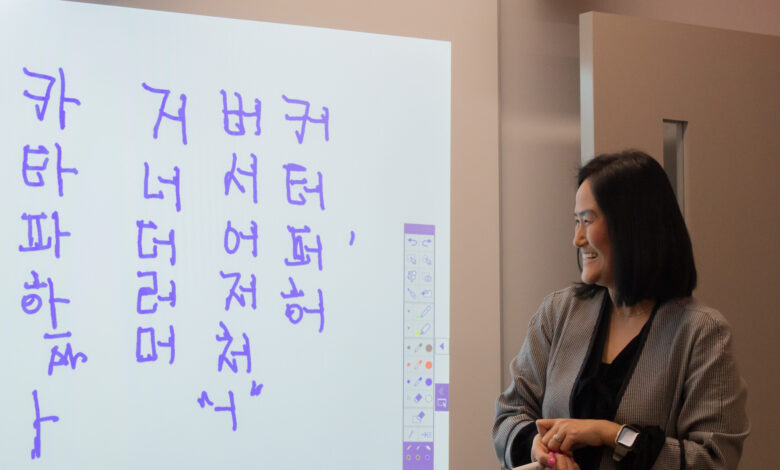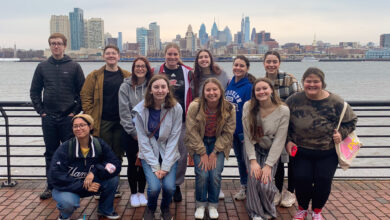
‘Hangul 101’ with CDO sparks cultural appreciation
By Madison Lewis
Language is the root of interpersonal connection and can lead to cultural appreciation, a phenomenon discovered by a handful of Rider students who chatted, and even argued, about how attractive Korean-drama protagonists are after learning how to write their names in Korean.
A small, yet engaged, group of students congregated in the Center for Diversity and Inclusion’s living room and were given paper with the Korean alphabet and other helpful phrases as part of a “Hangul 101” program on April 10.
Heeyoung Kim, the CDI’s director and chief diversity officer, taught the students Hangul, the official writing system throughout Korea, as attendees followed along and wrote the characters on their own. While they wrote, Kim passed around the Korean written adaptation of “Beauty and the Beast.”
After learning the 24 letters of Hangul, students asked Kim to write all of their names, while everyone discussed various topics surrounding Korean culture, such as how to pronounce “tteok-bokki” and why writing names in red ink was considered “bad luck.”
Kim was an international student from Korea who ventured to the United States to obtain a doctoral degree in 1999, and said she did not want to be alienated by the people around her and to learn about American culture.
The Asian American Pacific Islander Heritage Month event, created and hosted by the student workers in CDI, not only taught students about writing Korean letters, but allowed participants to discuss their appreciation of food, media and literature from Korea.
Kim said, “Learning different cultures is starting from the food and the languages.”
According to Kim, the Asian American Pacific Islander Heritage Month celebrations on campus are promoted through a universitywide email announcement, a QR code outside the CDI and on Instagram.
Kim called the advertising strategy a “huge improvement,” because the programs received more traction and attendees than previous years.
The intended audience for this event, according to Kim, was everyone. According to Dr. Kim, about 43 to 45% of Rider students are from different ethnicities and races other than whites while 85% of faculty and staff are caucasian, which limited student exposure to different cultures.
Kim described hesitations surrounding students coming to culturally influenced events, but said that “seeing someone you know like Dr. Kim” could ease some of the uncertainty and encourage a student to seek out exposure to new cultures.
Sophomore accounting major Leila Johnson, who goes by she/they pronouns, said they are a quarter Korean and has the Korean name Park Daesun. She said she went to the event because there was “not a lot of Korean representation on campus yet,” as well as to support Kim.
They said there were more Korean clubs forming that they held executive board positions on, such as Korean Pop Culture Club, the Korean Culture Association and the Asian American Student Association.
Johnson agreed that there are students who would appreciate more events surrounding Korean culture. “I saw [the CDI living room] getting louder and louder talking about K-dramas. There is definitely an interest and a buzz when it comes to Korean culture on campus.”
Johnson learned Korean and English at the same time, but lost the Korean language while growing up in the U.S., and intended to “brush up” on the language.
She said that she was disappointed the university did not have a Korean class and would be interested in seeing one on campus.
Kim discussed the possibility of a Korean class on campus if people were interested in speaking out, and she was proud that the students who participated in the Hangul event were so excited to take action.
Hangul 101,” though only an hour-long activity, not only taught basic language skills, but created a foundation of cultural appreciation and interest in a few eager students.

